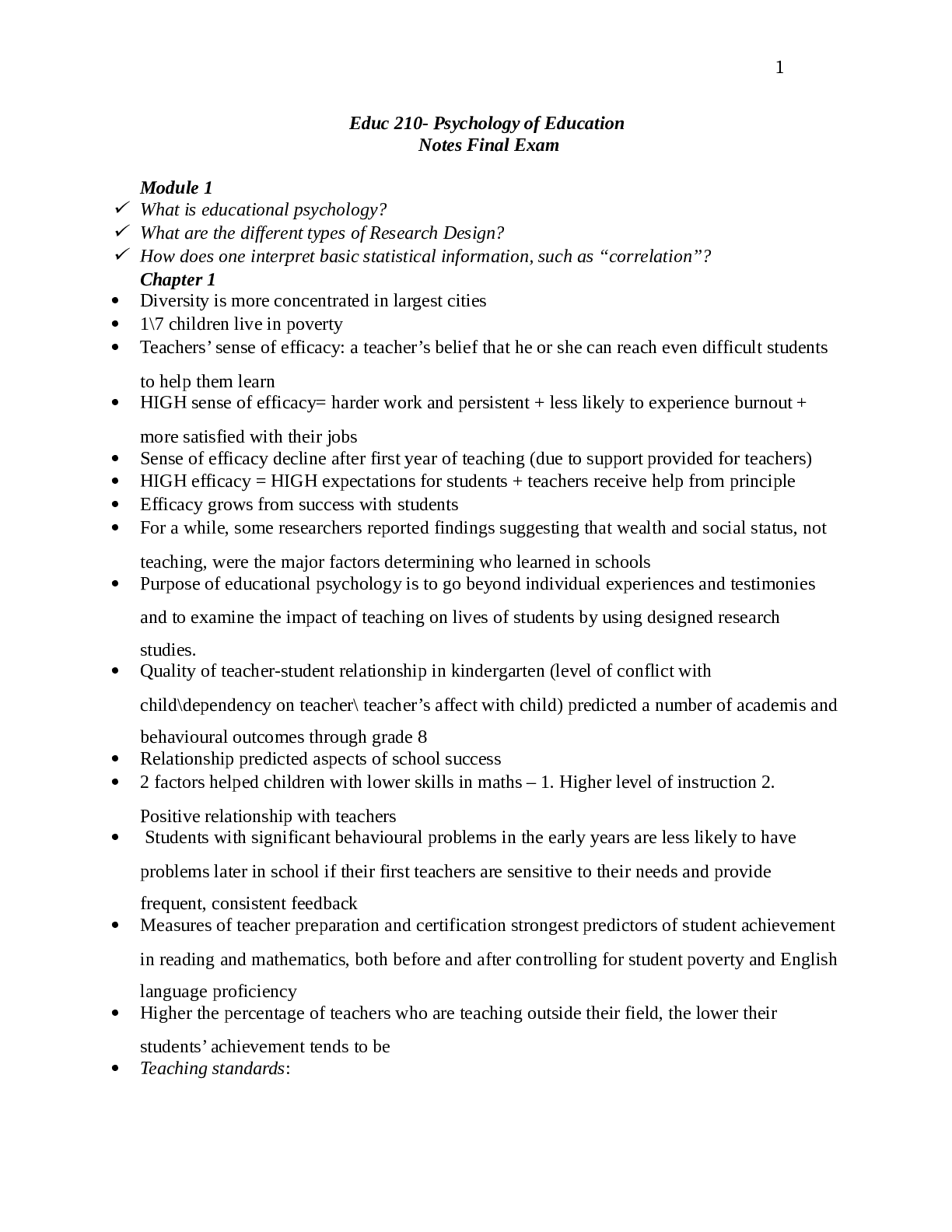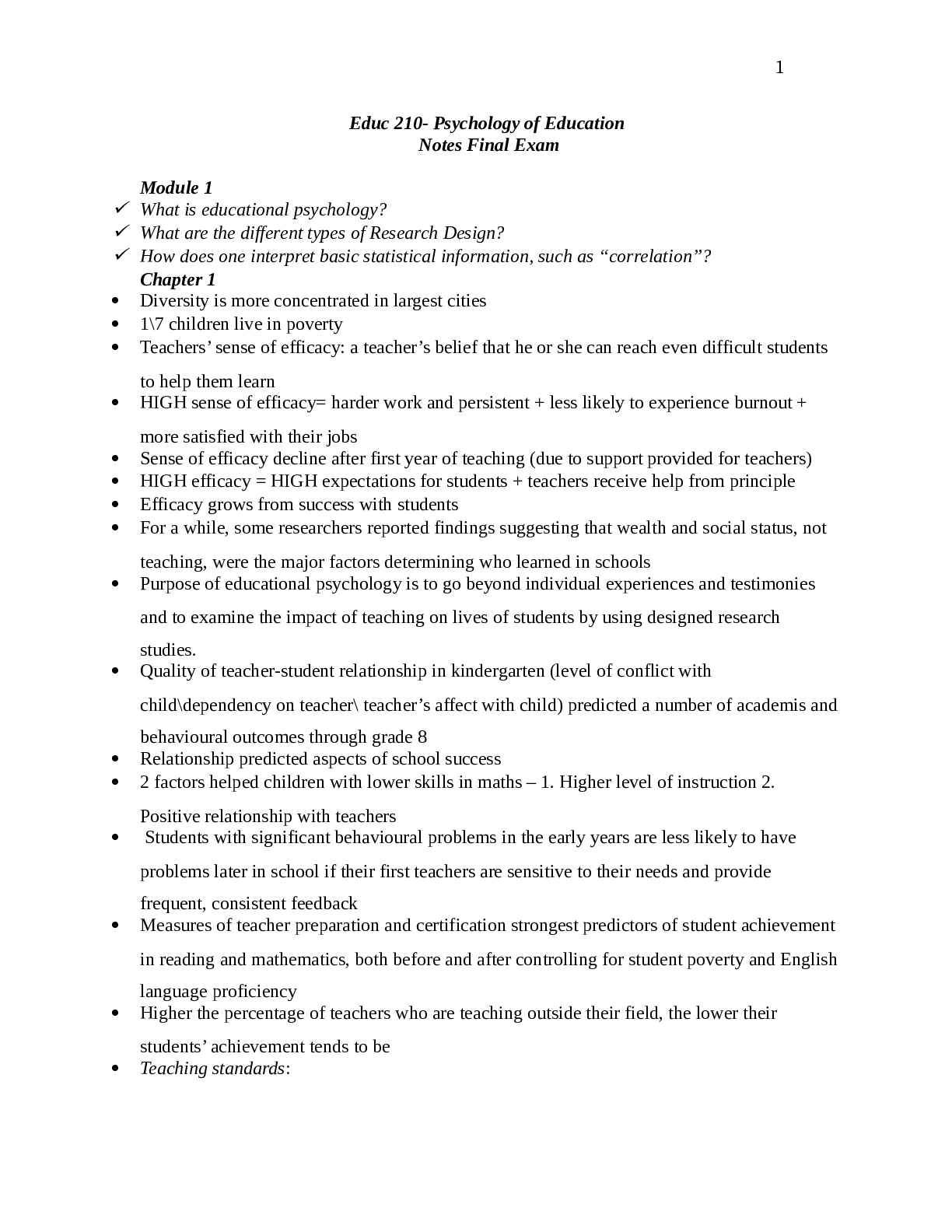Module 1
What is educational psychology?
What are the different types of Research Design?
How does one interpret basic statistical information, such as “correlation”?
Chapter 1
Diversity is more concentrated in largest cities
1\7 children live in poverty
Teachers’ sense of efficacy: a teacher’s belief that he or she can reach even difficult students
to help them learn
HIGH sense of efficacy= harder work and persistent + less likely to experience burnout +
more satisfied with their jobs
Sense of efficacy decline after first year of teaching (due to support provided for teachers)
HIGH efficacy = HIGH expectations for students + teachers receive help from principle
Efficacy grows from success with students
For a while, some researchers reported findings suggesting that wealth and social status, not
teaching, were the major factors determining who learned in schools
Purpose of educational psychology is to go beyond individual experiences and testimonies
and to examine the impact of teaching on lives of students by using designed research
studies.
Quality of teacher-student relationship in kindergarten (level of conflict with
child\dependency on teacher\ teacher’s affect with child) predicted a number of academis and
behavioural outcomes through grade 8
Relationship predicted aspects of school success
2 factors helped children with lower skills in maths – 1. Higher level of instruction 2.
Positive relationship with teachers
Students with significant behavioural problems in the early years are less likely to have
problems later in school if their first teachers are sensitive to their needs and provide
frequent, consistent feedback
Measures of teacher preparation and certification strongest predictors of student achievement
in reading and mathematics, both before and after controlling for student poverty and English
language proficiency
Higher the percentage of teachers who are teaching outside their field, the lower their
students’ achievement tends to be
Teaching standards:
2 Point: School renewal depends on what the teacher knows and can do to enhance their
student’s learning
Counterpoint: Teaching standards have more to do with punishing teachers rather than
enhancing their professionalism. it is unfair to create standards as a set of responsibilities for
teachers without also acknowledging the responsibility of employers (i.e., school and district
administrators, governments) to ensure that conditions are met that enable teachers to meet
the standards
Teachers must deal with a wide range of student abilities and challenges: different
languages, different home situations, and different abilities and disabilities
Reflective- Thoughtful and inventive. Reflective teachers think back over situations to
analyze what they did and why, and to consider how they might improve learning for their
students
Good teacher: Teachers must be both knowledgeable and inventive. They must be able to use
a range of strategies, and they must also be able to invent new strategies. They must have
some basic research-based routines for managing classes, but they must also be willing and
able to break from the routine when the situation calls for change. They must know the
research on student development, “patterns common to particular ages, culture, social class,
geography, and gender”, and they also need to know their own particular students, who are
unique combinations of culture, gender, and geography. Personally, we hope you all become
teachers who are both “sages” and “guides,” wherever you stand.
Students differ in knowledge of subjects, language, socioeconomic status, culture, race and
ethnicity. Bring different strengths, abilities and challenges.
To take advantage of such differences, Differentiated instructions should be given to take
advantage of the diversity, not ignore it
Elements of differentiation: students- seeking purpose, challenge, affirmation, power, and the
chance to contribute. Teacher- views these different student needs as opportunities, not
problems, and responds with invitation, investment, persistence, opportunity, and reflection.
Curriculum and instructions- The teacher works to create curriculum and instruction for each
student that is focused, engaging, demanding, important, and scaffolded
Cogs of differentiation: are interdependent and interlocking, like the inner workings of a
clock. Each student’s needs interact and connect with the differentiated curriculum and
instruction created by the teacher for that student.
Read More


